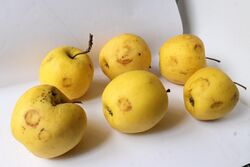Biology:Trichovirus
| Trichovirus | |
|---|---|

| |
| Apple chlorotic leafspot virus | |
| Virus classification | |
| (unranked): | Virus |
| Realm: | Riboviria |
| Kingdom: | Orthornavirae |
| Phylum: | Kitrinoviricota |
| Class: | Alsuviricetes |
| Order: | Tymovirales |
| Family: | Betaflexiviridae |
| Subfamily: | Trivirinae |
| Genus: | Trichovirus |
Trichovirus is a genus of viruses in the order Tymovirales, in the family Betaflexiviridae. Plants, specifically angiosperms such as pome fruits, citrus, and pear, serve as natural hosts for this plant pathogen. There are seven species in this genus.[1][2]
Taxonomy
The following species are assigned to the genus:[2]
- Apple chlorotic leaf spot virus
- Apricot pseudo-chlorotic leaf spot virus
- Cherry mottle leaf virus
- Grapevine berry inner necrosis virus
- Grapevine Pinot gris virus
- Peach mosaic virus
- Phlomis mottle virus
Structure
Viruses in Trichovirus are non-enveloped, with flexuous and filamentous geometries. The diameter is around 10-12 nm, with a length of 640-760 nm. Genomes are linear, around 7.5-8.0kb in length. The genome codes for 3 proteins.[1]
| Genus | Structure | Symmetry | Capsid | Genomic arrangement | Genomic segmentation |
|---|---|---|---|---|---|
| Trichovirus | Filamentous | Non-enveloped | Linear | Monopartite |
Life cycle
Viral replication is cytoplasmic. Entry into the host cell is achieved by penetration into the host cell. Replication follows the positive stranded RNA virus replication model. Positive stranded RNA virus transcription is the method of transcription. The virus exits the host cell by tubule-guided viral movement. Plants, pome fruits, citrus, and pear serve as the natural host. Transmission routes are grafting.[1] It is transmitted by mites of the family Eriophyidae, requiring a helper virus for transmission.
| Genus | Host details | Tissue tropism | Entry details | Release details | Replication site | Assembly site | Transmission |
|---|---|---|---|---|---|---|---|
| Trichovirus | Pome fruits; citrus; pear | None | Viral movement; mechanical inoculation | Viral movement | Cytoplasm | Cytoplasm | Grafting; propagating material |
References
- ↑ Jump up to: 1.0 1.1 1.2 "Viral Zone". ExPASy. http://viralzone.expasy.org/all_by_species/273.html. Retrieved 15 June 2015.
- ↑ Jump up to: 2.0 2.1 "Virus Taxonomy: 2020 Release". International Committee on Taxonomy of Viruses (ICTV). March 2021. https://ictv.global/taxonomy.
External links
Wikidata ☰ Q3539032 entry
 |

